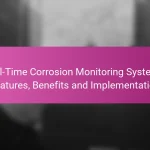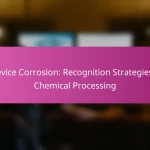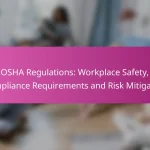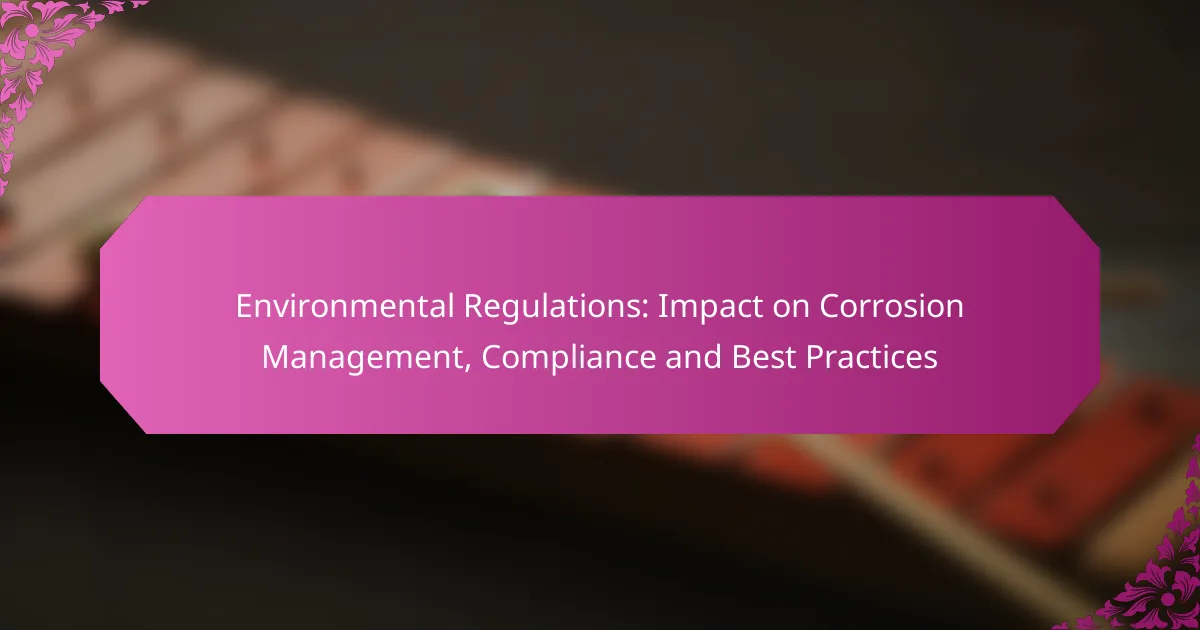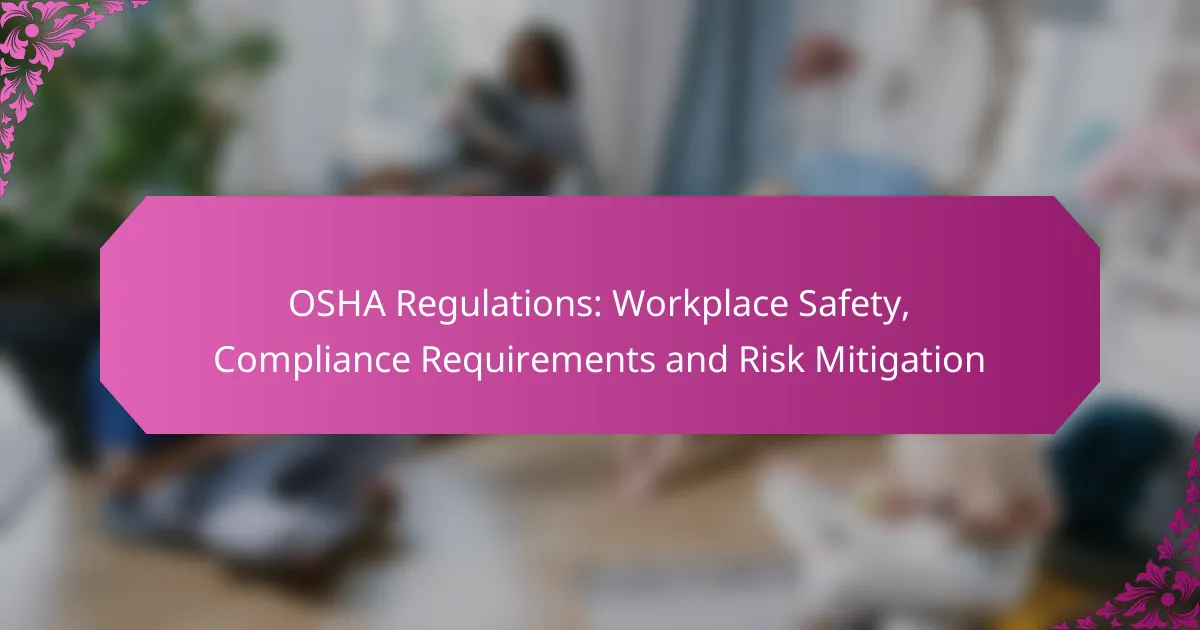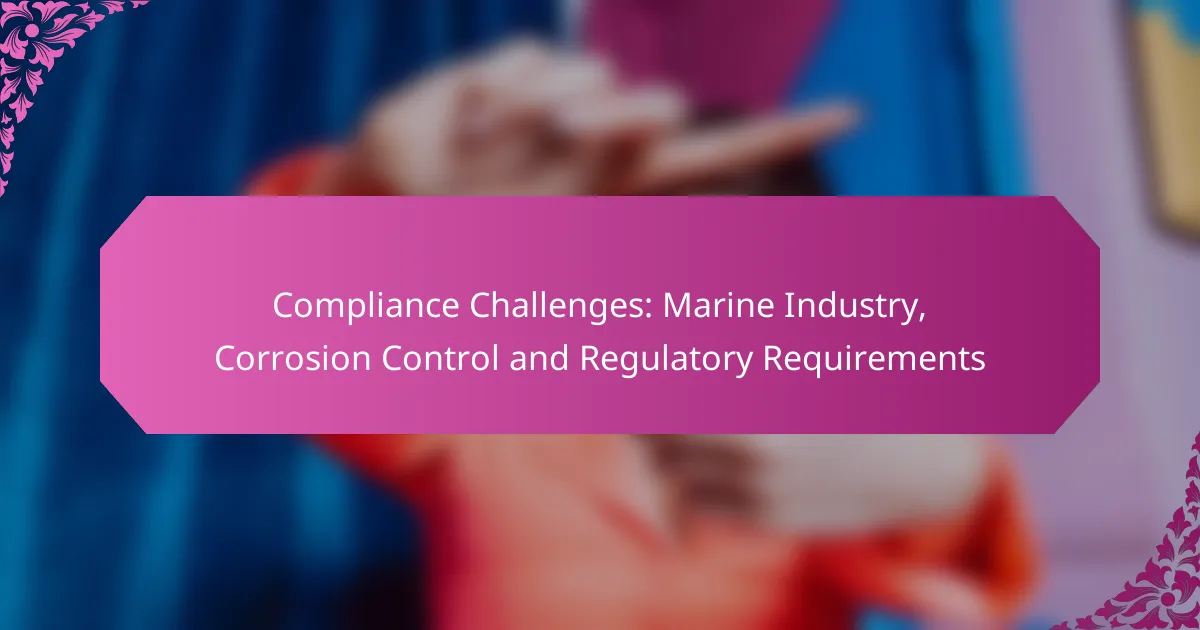Environmental regulations play a crucial role in shaping corrosion management practices across industries by setting standards aimed at reducing environmental impact. Compliance with these regulations requires systematic approaches, including regular audits and the implementation of advanced monitoring technologies, to ensure effective corrosion control while adhering to legal requirements.
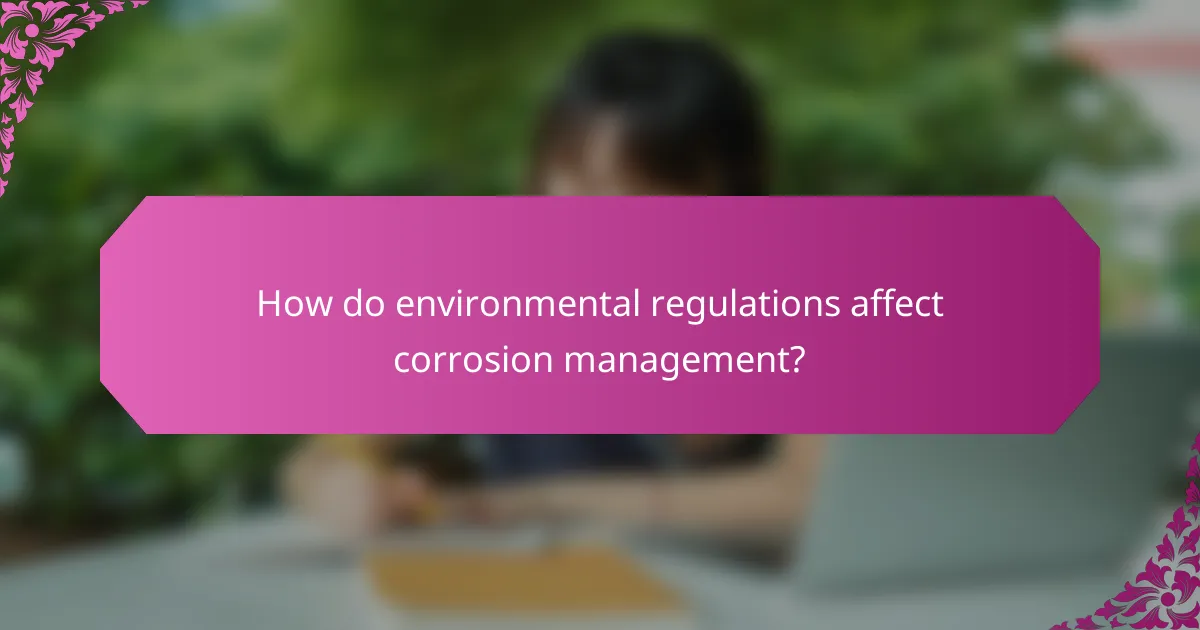
How do environmental regulations affect corrosion management?
Environmental regulations significantly influence corrosion management by establishing standards that industries must follow to minimize environmental impact. These regulations dictate how materials are selected, how maintenance is conducted, and the overall strategies for managing corrosion in various settings.
Regulatory compliance requirements
Regulatory compliance requires industries to adhere to specific guidelines that govern the use of materials and practices to mitigate corrosion. These guidelines often include limits on emissions, waste disposal, and the use of hazardous substances. Companies must regularly assess their operations to ensure they meet these standards, which may involve audits and reporting.
Failure to comply with these regulations can result in substantial fines, legal action, and damage to a company’s reputation. Therefore, understanding the relevant regulations is crucial for effective corrosion management.
Impact on material selection
Environmental regulations affect material selection by promoting the use of corrosion-resistant materials that have a lower environmental impact. For instance, industries may opt for non-toxic coatings or alloys that comply with environmental standards. This shift can lead to increased upfront costs but may reduce long-term maintenance expenses.
Additionally, companies must consider the lifecycle of materials, including their recyclability and the environmental footprint of their production. Choosing sustainable materials can enhance compliance and improve overall corrosion management strategies.
Influence on maintenance practices
Regulations often dictate the frequency and methods of maintenance to prevent corrosion-related failures. Industries may be required to implement routine inspections and maintenance schedules that align with regulatory standards. This proactive approach helps in identifying corrosion early and addressing it before it leads to significant damage.
Moreover, maintenance practices may need to incorporate environmentally friendly methods, such as using biodegradable cleaning agents or non-toxic corrosion inhibitors, to comply with regulations while effectively managing corrosion.
Cost implications for industries
Adhering to environmental regulations can lead to increased costs for industries, particularly in the initial stages of compliance. Expenses may arise from upgrading materials, implementing new maintenance practices, and conducting regular audits. However, these costs can be offset by reduced downtime and lower repair expenses in the long run.
Industries should conduct a cost-benefit analysis to understand the financial implications of compliance versus the potential costs of non-compliance. Investing in corrosion management that meets regulatory standards can ultimately lead to savings and improved operational efficiency.

What are the best practices for compliance with environmental regulations?
Best practices for compliance with environmental regulations involve systematic approaches to ensure adherence to laws while minimizing environmental impact. Key strategies include regular audits, staff training, and the use of advanced corrosion monitoring technologies.
Regular audits and assessments
Conducting regular audits and assessments is essential for maintaining compliance with environmental regulations. These evaluations help identify potential non-compliance issues and areas for improvement in corrosion management practices.
Audits should be scheduled at least annually and can include both internal reviews and external assessments by third-party experts. This ensures that all aspects of corrosion management are scrutinized, including materials used, maintenance practices, and waste disposal methods.
Training programs for staff
Implementing comprehensive training programs for staff is crucial for ensuring that employees understand environmental regulations and their role in compliance. Training should cover topics such as corrosion prevention techniques, regulatory requirements, and emergency response procedures.
Regular refresher courses can help keep staff updated on any changes in regulations or best practices. Engaging employees through hands-on training and simulations can enhance their understanding and retention of critical information.
Implementation of corrosion monitoring technologies
Utilizing corrosion monitoring technologies is a proactive approach to compliance with environmental regulations. These technologies can include sensors, real-time monitoring systems, and predictive analytics to assess corrosion rates and predict failures.
By integrating these technologies, organizations can detect corrosion early and take corrective actions before significant damage occurs. This not only helps in maintaining compliance but also reduces maintenance costs and extends the lifespan of assets.

What are the key environmental regulations impacting corrosion management?
Key environmental regulations that impact corrosion management include the Clean Water Act, Resource Conservation and Recovery Act, and National Environmental Policy Act. These regulations set standards for water quality, waste management, and environmental assessments, which directly influence how corrosion is managed in various industries.
Clean Water Act
The Clean Water Act (CWA) regulates discharges of pollutants into U.S. waters and establishes quality standards for surface waters. For corrosion management, compliance with the CWA means ensuring that any runoff or wastewater from facilities does not contain harmful levels of corrosive substances that could damage aquatic ecosystems.
Facilities must implement best management practices (BMPs) to prevent corrosion-related pollutants from entering waterways. This can include regular monitoring of water quality and the use of corrosion inhibitors that are environmentally safe.
Resource Conservation and Recovery Act
The Resource Conservation and Recovery Act (RCRA) governs the disposal of solid and hazardous waste. In terms of corrosion management, it requires facilities to manage waste materials that may be corrosive or contain corrosive substances properly. This includes ensuring that containers and storage methods are resistant to corrosion to prevent leaks and environmental contamination.
Facilities should conduct regular audits of their waste management practices to ensure compliance with RCRA. This may involve using corrosion-resistant materials for storage and transportation of hazardous waste, as well as training staff on proper handling procedures.
National Environmental Policy Act
The National Environmental Policy Act (NEPA) mandates federal agencies to assess the environmental effects of their proposed actions before making decisions. For corrosion management, this means that projects involving materials prone to corrosion must undergo thorough environmental reviews to identify potential impacts on ecosystems.
When planning new projects, organizations should conduct comprehensive corrosion assessments as part of their NEPA evaluations. This proactive approach helps in identifying risks and implementing mitigation strategies to minimize corrosion-related environmental impacts.

How can industries ensure compliance with corrosion management regulations?
Industries can ensure compliance with corrosion management regulations by developing structured strategies, engaging with regulatory bodies, and utilizing specialized software. These steps help organizations effectively manage corrosion risks while adhering to legal requirements.
Developing a compliance strategy
Creating a compliance strategy involves identifying relevant regulations and standards that apply to your industry. This includes understanding local laws and international guidelines that govern corrosion management practices.
Key steps include conducting a thorough risk assessment to determine potential corrosion issues, establishing clear policies, and defining responsibilities within your organization. Regular training for staff on compliance requirements is also essential.
Engaging with regulatory bodies
Active engagement with regulatory bodies can help industries stay informed about changes in corrosion management regulations. This can include participating in industry forums, attending workshops, and maintaining open lines of communication with regulators.
By building relationships with these organizations, companies can gain insights into best practices and receive guidance on compliance challenges. This proactive approach can also facilitate smoother inspections and audits.
Utilizing corrosion management software
Corrosion management software can streamline compliance efforts by automating data collection, analysis, and reporting. These tools help track corrosion rates, maintenance schedules, and regulatory requirements in real-time.
Choosing the right software involves evaluating features such as user-friendliness, integration capabilities with existing systems, and support for regulatory reporting. Regular updates and training on the software can enhance its effectiveness in maintaining compliance.
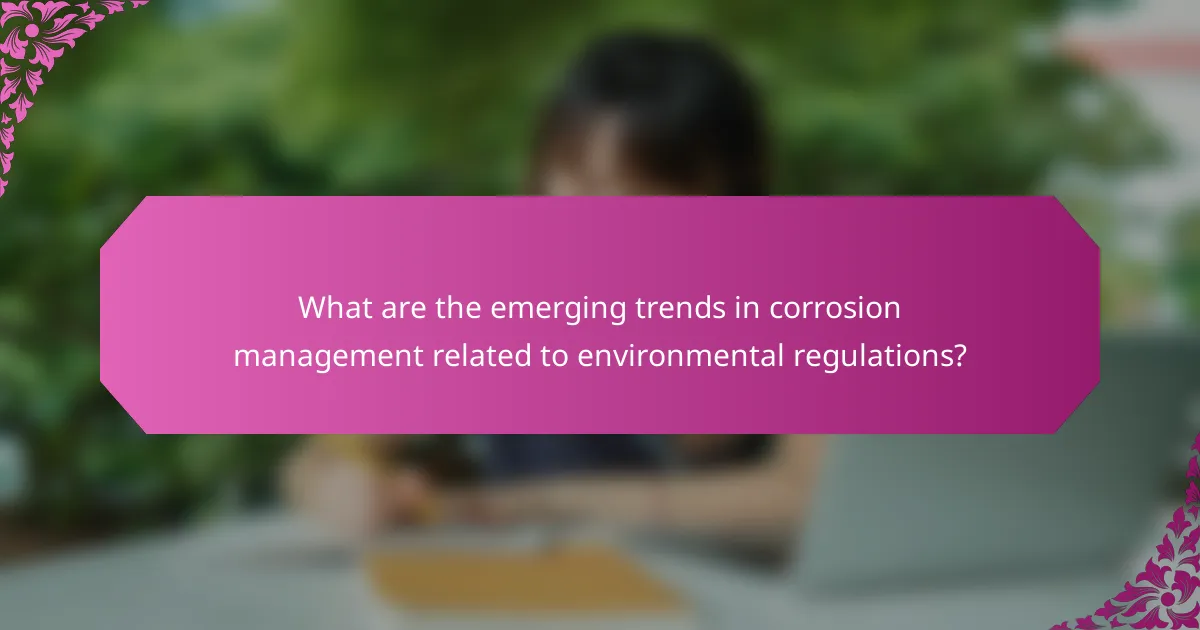
What are the emerging trends in corrosion management related to environmental regulations?
Emerging trends in corrosion management are increasingly shaped by stringent environmental regulations that promote sustainability and efficiency. Companies are adopting innovative practices and technologies to minimize environmental impact while ensuring compliance with evolving standards.
Adoption of sustainable materials
The shift towards sustainable materials is a key trend in corrosion management driven by environmental regulations. By using materials that are less harmful to the environment, such as bio-based coatings and recycled metals, companies can reduce their ecological footprint.
For example, utilizing corrosion-resistant alloys that are derived from recycled sources not only meets regulatory requirements but also enhances durability. This approach can lead to long-term cost savings and improved performance in various applications.
Integration of AI in monitoring
Artificial Intelligence (AI) is revolutionizing corrosion monitoring by providing real-time data analysis and predictive maintenance capabilities. AI systems can analyze vast amounts of data from sensors to identify corrosion patterns and predict potential failures before they occur.
Implementing AI-driven solutions can streamline compliance with environmental regulations by ensuring timely maintenance and reducing the likelihood of leaks or spills. Companies can leverage these technologies to enhance safety and minimize environmental risks associated with corrosion.
Focus on circular economy practices
Emphasizing circular economy practices is becoming essential in corrosion management as regulations increasingly favor sustainability. This approach encourages the reuse and recycling of materials, reducing waste and resource consumption.
For instance, businesses can implement strategies to reclaim and refurbish corroded components rather than discarding them. This not only aligns with regulatory frameworks but also fosters innovation and cost efficiency in operations.

How does corrosion management vary across different industries?
Corrosion management differs significantly across industries due to varying environmental conditions, materials used, and regulatory requirements. Each sector must adopt tailored strategies to effectively mitigate corrosion risks and ensure compliance with relevant standards.
Oil and gas sector challenges
The oil and gas sector faces unique corrosion management challenges due to its exposure to harsh environments, including high temperatures, pressures, and corrosive substances. These factors can accelerate corrosion rates, leading to potential safety hazards and costly downtime.
To manage corrosion effectively, companies often implement a combination of protective coatings, cathodic protection, and regular inspections. For instance, using corrosion-resistant alloys and applying protective coatings can significantly extend the lifespan of pipelines and equipment.
Additionally, compliance with regulations such as the American Petroleum Institute (API) standards is crucial. Companies should regularly assess their corrosion management practices to ensure they meet industry benchmarks and maintain operational integrity.
